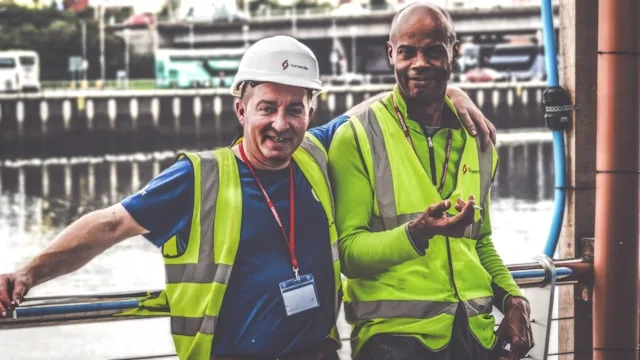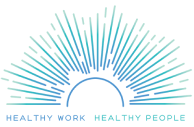A note from HWC Co-Directors, Marnie Dobson & Peter Schnall
The world has vastly changed since our last newsletter (December 2019) as we face an unprecedented global pandemic. The coronavirus (specifically COVID-19, named after the year it was discovered) has changed our personal lives dramatically as we try to slow its spread, or “flatten the curve,” in order to prevent an overwhelming load of hospitalizations and deaths. For those families who have lost loved ones, we offer our sincere condolences. Most Americans are now saving lives by self-isolating in our homes and – if we are fortunate enough to still have a job – trying to work remotely while in some cases also homeschooling children or caring for other loved ones. Sadly, the world of work has transformed in unimaginable ways for over 16 million Americans who now find themselves jobless (possibly to be joined by millions more), filing unemployment insurance claims for the first time. And we at the Healthy Work Campaign are grappling with how a conversation about “healthy work” (or lack thereof) can be useful during this uncertain time when many of us are simply grateful to have a job or even remain alive.
While so many sectors of the economy are affected, workers in the service industries, including restaurant, bar and hotel workers, personal service workers (hair stylists, nail salon and massage workers), care workers (nannies, housekeepers, child and elder care workers), as well as gig workers like Lyft and Uber drivers, were in the first industries to close down. Many of these workers are in “precarious” employment situations and will be the hardest hit by loss of work. Many make very low incomes, live paycheck to paycheck, have variable hours, often work in private homes, and may not have access to health care, sick leave or unemployment insurance when, right now, they need it most.
The CARES Act was approved and signed into law, a $2 trillion stimulus bill that offers direct assistance to individuals earning under $75,000/year and extends unemployment insurance to some of these precarious workers (but not all), who were previously ineligible. And the National Domestic Workers Alliance, among other worker organizations, started a Coronavirus Care Fund to provide emergency assistance to their members. But will these efforts be enough to buffer the financial impact—let alone slow the spread?
With over 1.3 million positive COVID-19 cases worldwide as of April 7, 2020, millions of Americans still face the threat of serious illness, hospitalization and even death due to the novel virus. When we think about “unhealthy work” now, we are especially thinking of the very real threat to life facing health care workers on the front lines of this epidemic trying to help thousands of people seriously ill from COVID-19. Nurses and doctors have been outspoken across the country, but especially in hard hit areas like New York, about the lack of needed medical supplies – including ventilators – as well as Personal Protective Equipment (PPE), like N95 masks, face shields, gowns and gloves. Sadly many of these front line workers, risking their lives to save the victims of COVID-19, live in fear of becoming ill or infecting their own families, as some have become sick and even died. Even more ill-equipped, but also essential workers on the front lines, are all the transportation and food service workers—including grocery store clerks helping people with their groceries on the checkout lines sometimes without masks or protective barriers.
We must ask, how can this happen in one of the richest countries in the world, that doctors and nurses cannot get the equipment they need to save lives and protect themselves? When we look back at the obfuscation and missteps, can we overcome the delays and get ahead of this outbreak? It seems very unlikely at this stage.
As we assess the ongoing goals of the Healthy Work Campaign, we believe the time is right to think about the broad structural inequalities in the United States that are putting so many of our most vulnerable citizens and working people at greatest risk from this virus. While the virus is affecting people across the socioeconomic spectrum, those with lower incomes and precarious jobs are also more likely to have underlying health conditions, making them more likely to get seriously ill and to not have the resources to take care of themselves or their families. Whereas, those with higher incomes are more likely to be shielded, with jobs that allow them to work from home and so practice social distancing, and also continue getting an income or paid sick leave. Healthy work is therefore much broader than just the workplace or the individual “well-being” of workers. We must consider broader inequalities in the labor market—the effects of a lack of employment security and other social protections which leave the United States, in a time like this, scrambling to make up a tremendous deficit.
For now, the HWC will continue to support all aspects of occupational safety and health concerns, as well as health care and food service worker unions who are on the front lines, struggling to get adequate supplies of PPE, trying to clarify regulations for workers and employers, and demanding the necessary equipment in order to effectively fight this disease. We also want to share some important Fact Sheets that have been distributed by the Australian Council of Trade Unions (ACTU) and the American Federation of Teachers (AFTs) which remind us of the importance of the psychological health and safety of workers at this time. Unfortunately, but understandably, anxiety and stress are high, made higher by intensifying working conditions and inadequate safety protections. #HealthyWork continues to be an imperative for all of us. And we appreciate everything you are doing to join us in this effort.






